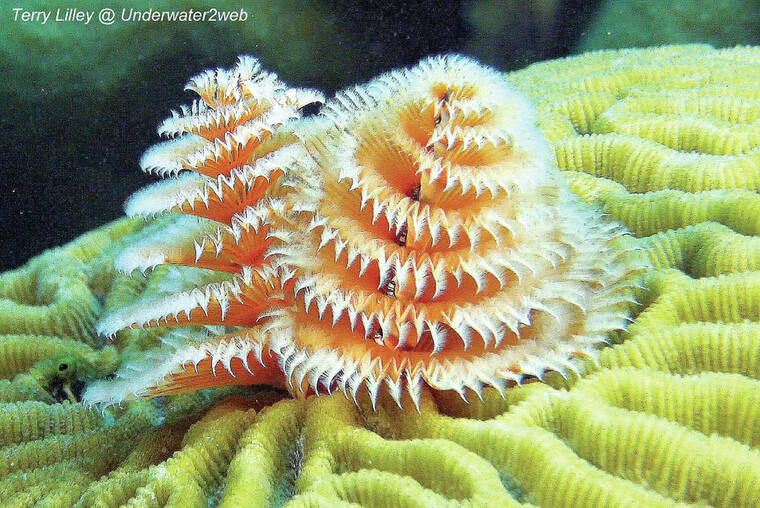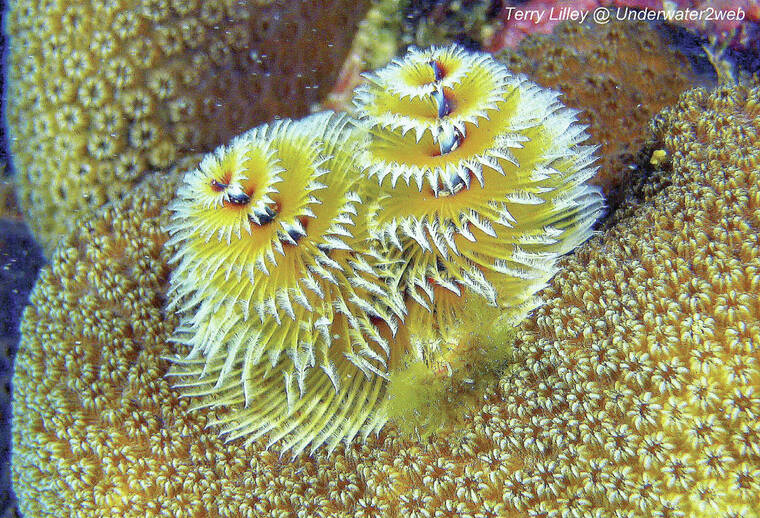Do you know that many of our coral reefs here in Hawai‘i are just covered in what looks like tiny, two-inch-long Christmas trees that grow on top of the live coral? There are some strange animals that grow in Hawaiian waters, and kio is one of them!
Do you know that many of our coral reefs here in Hawai‘i are just covered in what looks like tiny, two-inch-long Christmas trees that grow on top of the live coral? There are some strange animals that grow in Hawaiian waters, and kio is one of them!
These marine, tube-building worms burrow into the live coral up to eight inches deep and make a hard, calcium-carbonate tube for their slender body. On the top of their body, they have two crowns composed of radioles which are hair-like appendages that radiate from a central spine and look like mini Christmas trees. These appendages filter the surrounding seawater for floating phytoplankton for food, and are also used for breathing.
Just picture a forest of Christmas trees growing somewhere in Colorado, and when you walk through the forest the trees all disappear into the ground. That is exactly what the Christmas-tree worm does on the corals when a diver gets too close. The top part of the worm can retract within a split second into its long tube for protection, and it even has a trap door with a spike on it called an operculum that protects the soft worm from being eaten.
What is so interesting about kio is that it is both male and female and has no eyes. So how does it know a diver is coming too close? Most divers never see these worms because they approach the corals too quickly and the worms retract their colorful crowns into their tubes. Their crowns can be bright blue, yellow, orange, white and many other mixed colors. You have to go very slow to see kio, or wait calmly above the coral for a few minutes, and they will come back out.
We have done some fun tests to try and figure out how kio knows a diver is there or some kind of predator, and our findings are quite interesting. We tested for a change in light and also water movement, but the worm did not respond to either on a regular basis, so we tried an electromagnetic test. We took a wooden pole and slowly put it close to the worm’s crown and it did not retract, but when we took our finger and put it near the worm it did retract. Many underwater animals from sharks to slugs can detect the electrical current that emanates from all living creatures, as this current travels well in saltwater. So kio may not see us but can feel our biological energy.
You can see the Christmas-tree worm in action at underwater2web.com in an underwater-marine-life-educational movie series. Follow daily marine-life educational posts on Instrgram at terry.lilley. Have a wonderful holiday season and go hang out with our little underwater Christmas trees!
•••
Terry Lilley is a marine biologist living in Hanalei. He is co-founder of Reef Guardians Hawai‘i, a nonprofit on a mission to provide education and resources to protect the coral reef. To donate to Reef Guardians Hawai‘i go to reefguardianshawaii.org.




